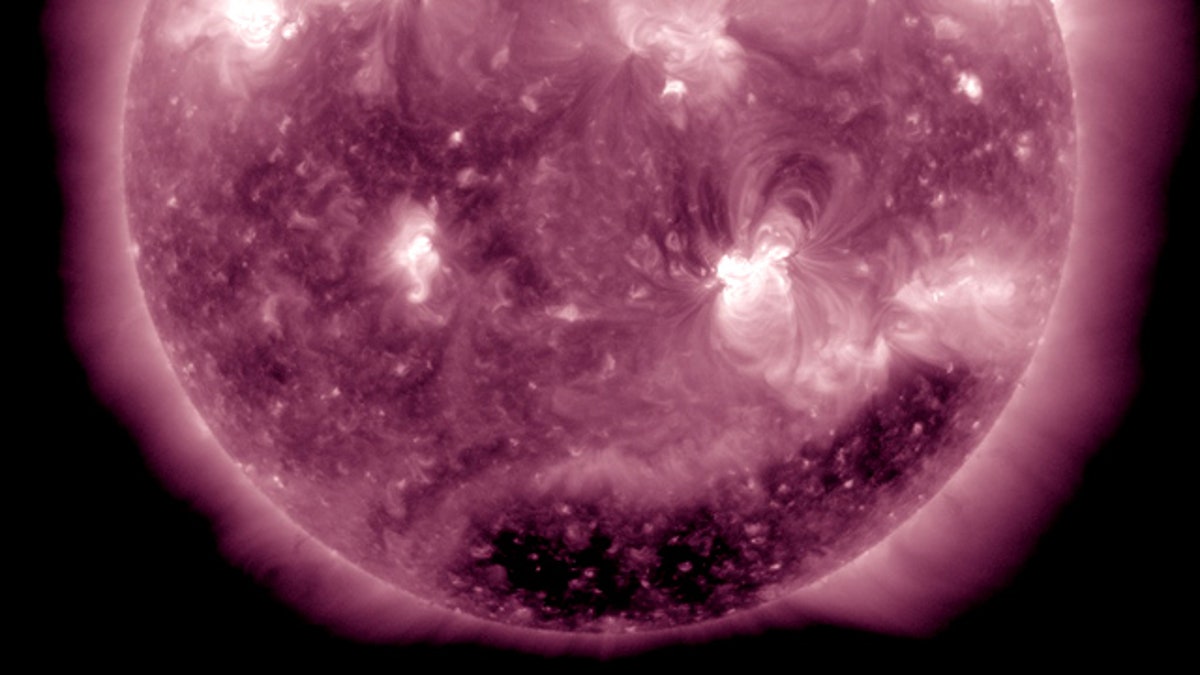
An X2.2 flare erupted from the sun's active region 1158 (at lower right) at about 0150 UT or 8:50 pm ET on February 14. (NASA/SDO/GFSC)
The sun unleashed its strongest solar flare in four years on Feb. 14, hurling a massive wave of charged particles from electrified gas into space and toward Earth.
The solar storm sent a flash of radiation that hit Earth in a matter of minutes; a huge cloud of charged particles headed our way. These "coronal mass ejections," as they are called, typically take around 24 hours or more to arrive. They can spark spectacular displays of the aurora borealis, or Northern Lights, at high latitudes and sometimes even into the northern United States.
The megaflare, which registered as a Class X2.2 flare on the scale of solar flares, was the first class X flare to occur in the new solar cycle of activity, which began last year. The sun is now ramping up toward a solar maximum around 2013, NASA said.
"It has been the largest flare since Dec 6, 2006, so a long time coming," said Phil Chamberlin, deputy project scientist for NASA's Solar Dynamics Observatory, which observed the flare. "There were some clues that led us to believe the likelihood of moderate to large flares (M class or above) could occur, but we were all surprised when it actually happened to be a large X-class."
Class X flares are the strongest types of solar flares that can erupt from the sun. There are also two weaker categories: Class M flares, which are medium strength but still powerful, and Class C flares, which are the weakest storms from the sun.
The X2.2 flare is the most powerful solar eruption of the sun's current weather cycle, called Solar Cycle 24. According to the website Spaceweather.com, which monitors space weather and skywatching events, the flare was the strongest of the last four years.
"It just means that Solar Cycle 24 is ramping up!" Chamberlin told SPACE.com. "This is the first of probably many more X-class flare to occur over the next 2 to 4 years as we reach the peak and then descend back down from solar cycle 24 maximum."
The Monday flare came on the heels of another, only slightly less powerful, class M6.6 flare on Sunday, Feb. 13. Both events erupted from the same area on the sun, called active region 1158.
"AR 1158 is in the southern hemisphere, which has been lagging the north in activity but now leads in big flares!" NASA scientists wrote on the Solar Dynamics Observatory website.
The Class X flare erupted at 8:50 p.m. EST on Feb.14 (0150 GMT Feb. 15).
Such a flare can bathe the Earth in high doses of ultraviolet radiation and X-rays hurl a huge burst of solar wind in our direction. When this burst arrives at Earth, the electrons and protons from the solar wind come into contact with our planet's magnetic field, and stream toward the magnetic poles.
The disturbance can create a geomagnetic storm in Earth's magnetic field.
"Geomagnetic storms are possible when the CME arrives 36 to 48 hours hence," Spaceweather.com reported.
* Amazing New Sun Photos From Space
* Sun Unleashes a Rare Double
* WhammyPhoto Shows Big Holes in the Sun
Copyright © 2011 Space.com. All Rights Reserved. This material may not be published, broadcast, rewritten or redistributed.
